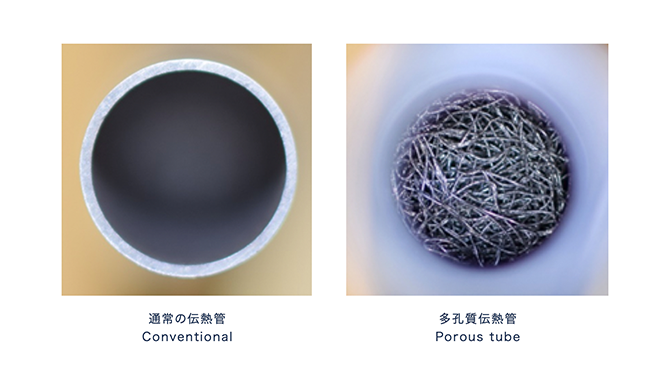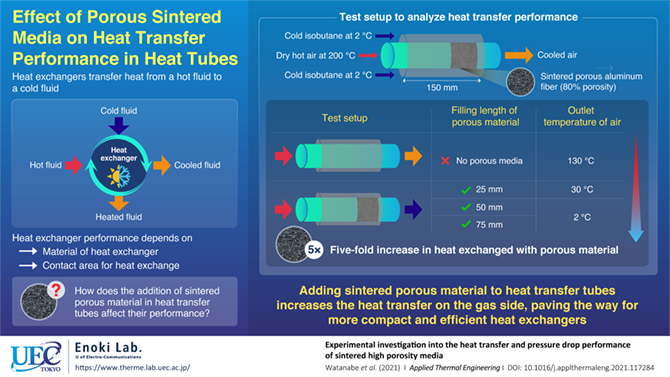2021.10.18
Porous media sintered inside heat transfer tubes reduces the thermal resistance and increases the area available for heat exchange, finds study
Heat exchangers are used in several industrial machine elements, making the optimization of their performance vital. In this regard, researchers from Japan investigated the heat transfer performance of a tube sintered with a porous material. They found that the procedure resulted in an increase in the amount of heat transferred. Their new approach does not require any external modifications, and it can easily be used to improve the efficiency of existing heat exchangers.
Despite their deceptively simple function of transferring heat from one medium to another, heat exchangers are of utmost importance in machines. Heat exchange between two fluids depends on the material of the heat exchangers, the contact area for heat exchange, and the properties of the fluid. For efficient heat exchange between fluids such as gases that have poor heat transfer properties, larger surfaces are required.
Porous materials such as granular porous media, foamed porous media, and fibrous porous media are emerging alternatives. These materials are not attached on the heat transfer tube but are filled inside it. Thus, this approach does not require tubes to be retrofitted or modified to hold fins and can be used in existing heat transfer tubes. Lately, however, it has been found that sintering the heat transfer tube and the porous media can improve the contact between the fiber and the wall of the tube, reducing thermal resistance and enhancing heat exchange. But just how large is the improvement in the heat transfer performance?
Now, in a study published in Applied Thermal Engineering, researchers from The University of Electro-Communications and Tokyo University of Agriculture and Technology, Japan, compared the heat transfer performance of tubes filled with a sintered porous material to that of normal conventional heat transfer tubes. The paper was made available online on 2nd July 2021, and it appeared in the print issue, Volume 196, on 1st September 2021.
The heat transfer performance of the setup was evaluated by measuring the temperature of air discharged after heat exchange. Dr. Koji Enoki, Associate Professor at The University of Electro-Communications, and one of the authors of this study, briefly explains the setup: "The inner diameter of the tube is about 10-20 mm, and the length of the tube is 150 mm. Dry air at 200 °C flows through the tube, and the outside of the tube is cooled with isobutane at a saturation temperature of 2 °C." The researchers then evaluated the heat transfer performance of the setup by measuring the temperature of air discharged after heat exchange.
For the conventional heat transfer tube (without the aluminum fiber), the air temperature at the outlet was observed to be around 130 °C. However, the temperature of the outlet air decreased significantly when the tubes were filled and sintered with the porous aluminum fiber. Additionally, for a filling length of 50 mm, the temperature of the air was found to drop down further, approaching the saturation temperature of isobutane (2 °C). Based on the temperature differences between the incoming and the outgoing air, the researchers calculated the heat transfer in the tubes sintered with porous media and found it to be five times greater than the conventional heat transfer tubes.
Dr. Enoki is optimistic that the improvement in heat transfer can pave the way for energy recovery from sources that are currently considered to be impractical or uneconomical with conventional heat transfer tubes, stating, "Since the heat transfer of gases is usually very poor, waste heat from factories below 200°C has been disposed of into the atmosphere for economic reasons. However, the heat transfer tubes presented here have succeeded in improving the heat transfer of gases by about 20 times compared to conventional tubes, making it possible to recover waste heat from factories."
"Considering the amount of energy that can be recovered in the future, it is no great exaggeration to say that we have been able to turn a rough diamond into a diamond," he adds.
| Authors | Ren Watanabe 1, Takuto Kobayashi 1, Yusuke Otomo 1, Atsushi Akisawa 2, Yuki Ueda 2, Koji Enoki 1* |
|---|---|
| Title of original paper | Experimental investigation into the heat transfer and pressure drop performance of sintered high porosity media |
| Journal | Applied Thermal Engineering |
| DOI | 10.1016/j.applthermaleng.2021.117284 |
| Affiliations | 1 The University of Electro-Communications, Japan 2 Tokyo University of Agriculture and Technology, Japan |
| Latest Article Publication Date | September 2021 |
| Method of Research | Experimental study |
| Subject of Research | Not Applicable |
| Conflict of Interest (COI) statement | The authors declare that they have no known competing financial interests or personal relationships that could have appeared to influence the work reported in this paper. |

In a recent study, researchers from Japan investigated the heat transfer performance of a tube sintered with a porous material. The use of porous aluminum sintered to the tube increases the contact area available for heat exchange, improving the efficiency of the heat exchange tube
Image courtesy: Koji Enoki from The University of Electro-Communications
Koji Enoki is an Associate Professor at the Graduate School of Mechanical and Intelligent Systems at The University of Electro-Communications. His main research interests are in heat exchangers, porous material, two-phase flow, and utilization of waste heat. He has published over 105 papers and a book on Mechanical system engineering experiments. He has received multiple awards from the Japan Society of Refrigerating and Air Conditioning Engineers, and the science publisher Elsevier for his research work.
